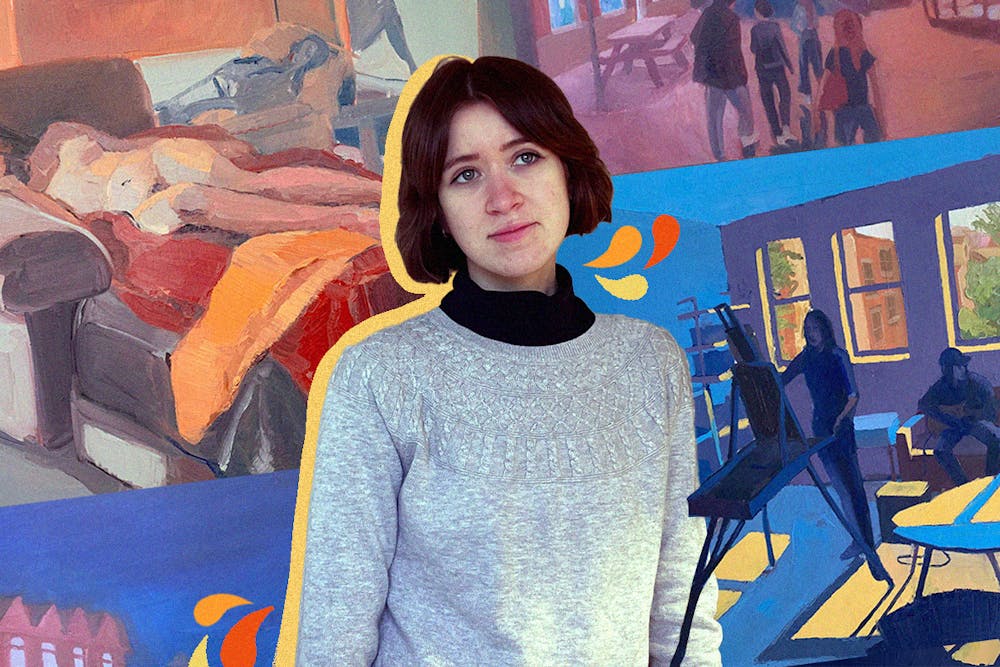A midnight blue paints the sky and streetlights adorn unassuming buildings, casting a soft glow on those passing by. This painted landscape is tranquil and uncomplicated—it could be any downtown suburban street. But in reality, it’s a dreamscape of Anna Hoppel’s (C ‘23) conception—incredibly real, yet entirely fictitious.
Anna is dual–enrolled in the Pennsylvania Academy of the Fine Arts (PAFA) and Penn. Their studies at Penn encompass the liberal arts—Anna is a fine arts major with a painting concentration—while their studies at PAFA hone their technical skills as an artist. Academic and technical studies aside, Anna is a student of life. Art is her desired form of communication because of the diversity and nuance its forms can take on. But they also reveal that “painting is a difficult way to pursue [visual communication] because you have to really sit with it, and interpret it.” Anna finds visual communication especially difficult in the modern world, “where you’re just scrolling through Instagram, seeing someone’s image for five seconds.” But that challenge is one she finds appealing, often asking herself: “Can I make a painting that will force someone to stop and stare at it?”
It was on a trip to Montreal that Anna found the inspiration for the hauntingly dreamy painting she would title after the real city, Le Plateau–Mont–Royal. The painting itself represents Anna's identity as an artist and an individual. Canvas and oil paints aren’t quite so easy to carry over country lines, so Anna traveled unaccompanied by their familiar tools, choosing to work from memory upon their return.
Le Plateau–Mont–Royal is an ode to hasty sketchbook outlines overlaid with memories and adorned with painted renditions of old photographs. Anna reinvents collaging as an art form, turning it into a mode of inspiration. This painting calls upon what she knows and loves—the bodega on the corner of her hometown in Philadelphia, and the memory of her friends meandering through a dim Montreal evening. But most importantly they express “what it means to be a traveler inhabit[ing] a space for a short amount of time.” Anna knows that “the feeling of being an outsider versus a member of the community” can be strange yet alluring. While the story behind the painting's creation was only revealed to me by Anna herself, the painting's sentiment can be felt by many. The secret of the painting’s eclectic inspiration manifests on canvas—it's Anna's purest expression of artistry.
Anna believes that the truth behind artistry reveals itself when we recognize beauty in raw expression—the act of being consumed by joy in a loved one’s presence, feeling the wash of relief cleansing oneself after times of stress, and the weight of anguish in a moment of loss.
The early days of quarantine were littered with those now–familiar feelings of loss, anguish, and sorrow. For Anna, it meant no longer being able to explore new landscapes and tell stories of places unexplored. She instead had to reflect and contemplate the fact that their surroundings were shrinking to a singular habitat. Anna became introspective in order to bring new worlds to life on canvas. They learned how to shed light on old feelings and experienced their stagnant surroundings from a new perspective.
Anna's work is largely inspired by the people, places, and perspectives around them. When asked about style and genre, they shared, “I [wouldn't] want to pigeonhole myself so early. I sort of associate with perceptual painting, which works from observation, but I also work from photography and sketches, so I don’t fit fully into that [genre] either.” Escaping the binaries of classification and observation inspires how Anna experiences their work as an artist.
Art is full of happy accidents. Anna even declares, “If I’m not experimenting and learning new things throughout the course of the paintings, why am I even doing it?” There’s no secret to making good art, and there’s no secret to viewing art either. Anna expresses, “The division between an artist and a normal person is so Western and so American. [Art] is so vague and abstract—it can be approached from so many different angles. It’s just way more accessible than most people think it is.”
Anna shares, “When I’m cooking, or playing music, or writing, or doing anything, it’s all coming from the same place,” that place of creativity and emotion. She believes everyone holds the ability to create and express within themselves.
We can learn to harness light and love, warming those around us, but we can also preserve it for our own enjoyment—both actions are incredibly valid and entirely honest forms of artistic expression. When we restrict expression with monetary and cultural barriers, we effectively lock the gates, preventing one another from experiencing these intangible expressions of life as art.
Anna's invaluable wisdom lingers in my mind as staggered strikes of lighting paint an otherwise darkened sky. I try to imagine how Anna would capture the light on this particular evening. Would they focus on the bolt’s iridescent reflection against the glass skyline? Or would her oil paints capture the tranquil shadows, reimagining tones of blue inhabiting the silence after light scatters?
I recall the echo of Anna's words as I contemplate the sky's performance unfolding above me—she believes “everybody has that creative thing … everybody is able to [create].” Perhaps the mental snapshots we take of moments in time, and accompanying reflection, are their own art form. We can see our surroundings as art in motion—because appreciation in itself can be the purest form of artistic expression.
Anna Hoppel’s senior exhibition will be on display at the Pennsylvania Academy of the Fine Arts from May 13 until June 5.







